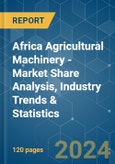Over the years, agricultural mechanization has become an integral component of agricultural development in the rest of the African countries, resulting in the evolution of agricultural machinery hire services. The expansion of agricultural productivity through increased investment into the segment for farm mechanization by the government has increased the adoption of autonomous agricultural machinery. Furthermore, the increasing trend toward sustainable mechanization, the growth of medium-sized farms, and the adoption of innovative technologies drive the market in the region. However, the reliance on traditional implements and the low income in certain African countries may hinder the market's growth.
Tractors dominated the agricultural machinery market. According to the South African Agricultural Machinery Association (SAAMA), in October 2022, tractor sales of 1,268 units were almost 48.1% more than the 856 units sold in October 2021. Year-to-date tractor sales were almost 30% up from last year. Thirty-four combine harvesters were sold in October 2022, a drop of 24.4% compared to October 2021. On a year-to-date basis, combine harvester sales witnessed an increase of 25% from last year. Individual ownership, collective ownership, fee-based service delivery, and leasing are the types of machinery usage systems followed in the region.
Africa Agricultural Machinery Market Trends
Increasing Focus on Sustainable Mechanization
Even though Sub-Saharan Africa has the highest global area of uncultivated arable land, productivity lags far behind other developing regions. Also, yields are only about half the international average, far below the growth levels needed to keep pace with food demand driven by population expansion. However, mechanization may dramatically improve the yield gap. Therefore, the focus on sustainable agricultural mechanization has been a prime developmental goal in the African region. Furthermore, in 2018, FAO and the African Union launched the Framework for Sustainable Agricultural Mechanization for Africa (SAMA), setting out a long-term vision and national and regional priorities, emphasizing cooperation with the agricultural machinery industry. Interventions could aim to move smallholders from hand-tool-based labor to innovative technologies. Sustainable mechanization relieves labor shortages, cuts working time, raises productivity, and encourages youth into agriculture to create jobs.In 2021, the European Agricultural Machinery Industry Association (CEMA) and the Food and Agriculture Organization of the United Nations (FAO) renewed their memorandum of understanding (MoU) on sustainable agricultural mechanization until 2025, which includes a focus on African countries.
Tractors Segment Dominates the Market
According to the research survey conducted by Agri evolution Alliance, Africa holds great market potential for agricultural machines, including tractors. The government's increasing support to develop this market is expected to drive this sector. For instance, the Ghana government provides subsidized tractors to entrepreneurs who run 89 centers that rent out and service tractors. In major parts of Africa, tractor sales were affected due to uncertainty regarding crop yields and exchange rates.Additionally, issues concerning land restitution and farmworkers' shares in farms added to the farmers' uncertain conditions. According to the latest report published by the South African Agricultural Machinery Association (SAAMA), tractor sales increased by 15.5% in September 2022 compared to September 2021. Tractor sales amounted to 6,479 units in September 2022, up from 5,610 units in September 2021. However, the region is currently facing major constraints that hamper the market's growth. One such limitation is the private sector's involvement, which is severely hampered by government resistance and corruption, affecting the imports of tractors.
Africa Agricultural Machinery Industry Overview
The African agricultural machinery market is relatively consolidated. The major players in the market include Deere & Company, AGCO Corporation , CNH Industrial NV, Claas KGaA mbH , and Mahindra & Mahindra Ltd. Major players in the market have extended their product portfolio and broadened their businesses to maintain their positions in the market. Expanding the product portfolio by introducing new and innovative products into the market is the most adopted strategy by these companies.Additional Benefits:
- The market estimate (ME) sheet in Excel format
- 3 months of analyst support
This product will be delivered within 2 business days.
Table of Contents
Companies Mentioned (Partial List)
A selection of companies mentioned in this report includes, but is not limited to:
- Tractors and Farm Equipment Limited (TAFE)
- Claas KGaA mbH
- AGCO Corporation
- Mahindra & Mahindra Ltd
- Kubota Agricultural Machinery
- Deere & Company
- Kverneland AS
- CNH Industrial NV
- J.C. Bamford Excavators Limited
- Kuhn Group
- Escorts Group
- Lindsay Corporation
Methodology

LOADING...










